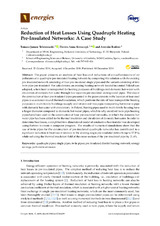Mostrar el registro sencillo del ítem
Reduction of Heat Losses Using Quadruple Heating Pre-Insulated Networks: A Case Study
| dc.contributor.author | Teleszewski, Tomasz Janusz | |
| dc.contributor.author | Krawczyk, Dorota Anna | |
| dc.contributor.author | Rodero Serrano, Antonio | |
| dc.date.accessioned | 2019-12-10T11:20:23Z | |
| dc.date.available | 2019-12-10T11:20:23Z | |
| dc.date.issued | 2019 | |
| dc.identifier.uri | http://hdl.handle.net/10396/19187 | |
| dc.description.abstract | The paper presents an analysis of heat loss and reductions of annual emissions of air pollutants of a quadruple pre-insulated heating network by comparing this solution with the existing pre-insulated network consisting of four pre-insulated single pipes and the variant consisting of two twin pipe pre-insulated. For calculations, an existing heating network located in central Poland was adopted, where heat is transported for heating purposes of buildings and domestic hot water with circulation of domestic hot water through four separate pre-insulated underground pipes. The idea of the construction of four pre-insulated pipes presented in the paper consists in the location of four steel pipes in a common round thermal insulation, which perform the role of heat transport for heating purposes in multi-family buildings (supply and return) and two pipes transporting hot water (a pipe with domestic hot water with circulation). In Poland, heating pipes used in multi-family housing have a larger diameter compared to domestic hot water pipes, which is why standard twin pipe heating pipes have been used in the construction of four pre-insulated networks, in which the domestic hot water pipe has been added to the thermal insulation and circulation of domestic hot water. In order to determine heat losses, a simplified two-dimensional model of conductive heat transfer was developed using Fortran to create a computer program. The results of numerical simulations show that the use of twin pipes for the construction of pre-insulated quadruple networks has contributed to a significant reduction in heat loss in relation to the existing single pre-insulated network (up to 57.1%), while reducing the thermal insulation field of the cross-section of the pre-insulated pipe by 21.4%. | es_ES |
| dc.format.mimetype | application/pdf | es_ES |
| dc.language.iso | eng | es_ES |
| dc.publisher | MDPI | es_ES |
| dc.rights | https://creativecommons.org/licenses/by/4.0/ | es_ES |
| dc.source | Energie 12(24), 4699 (2019) | es_ES |
| dc.subject | Quadruple pipes | es_ES |
| dc.subject | Single pipes | es_ES |
| dc.subject | Twin pipes | es_ES |
| dc.subject | Pre-insulated district heating | es_ES |
| dc.subject | Networks | es_ES |
| dc.subject | Energy savings | es_ES |
| dc.subject | Pollutants emission | es_ES |
| dc.title | Reduction of Heat Losses Using Quadruple Heating Pre-Insulated Networks: A Case Study | es_ES |
| dc.type | info:eu-repo/semantics/article | es_ES |
| dc.relation.publisherversion | http://dx.doi.org/10.3390/en12244699 | es_ES |
| dc.rights.accessRights | info:eu-repo/semantics/openAccess | es_ES |

